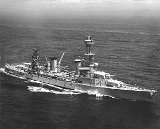
Pensacola class cruiser
Encyclopedia
The Pensacola class of United States Navy
heavy cruiser
s were the first "treaty cruisers", designed under the limitations set by the Washington Naval Treaty
, which limited cruisers to a maximum of 10,000 tons displacement and a maximum main battery caliber of 8 inches.
Flush-decked and with their main battery equally divided fore and aft, they were handsome and well proportioned ships.
Their main armament consisted of ten 8 in (203.2 mm) guns, in two twin turrets on the main deck, and two triple turrets two decks above, making it one of the two US Navy ship classes (besides the Nevada
-class battleships) to have different-sized turrets for main armament. All guns in each turret were mounted in a single slide, and were unable to elevate independently of each other. Also, unlike the very few other ships with different sized main battery turrets, these ships had the larger triple turrets mounted higher up than the smaller twin turrets. No other ships actually built shared this feature, although the original design for the Lexington-class battlecruisers would have shared this odd status as they called for ten 14 inches (355.6 mm) guns in triple turrets superfiring
over twin turrets. In this way they would have seemed like scaled up Pensacolas. Placing heavier turrets higher than lighter ones makes little sense in terms of topweight, but could make sense if heavy seas prevent use of lower turrets.
Unfortunately, because of the rather unusual main battery layout and their heavy tripod fore-masts, they were top-heavy and prone to excessive rolling. This combined with low freeboard forward made them inferior seaboats compared to later designs.
The Navy only built two ships in this class before switching to the design. Many of the deficiencies of the Pensacola-class were corrected by reducing the main battery to three triple turrets (two forward, one aft) and adding an additional upper deck forward of amidships.
United States Navy
The United States Navy is the naval warfare service branch of the United States Armed Forces and one of the seven uniformed services of the United States. The U.S. Navy is the largest in the world; its battle fleet tonnage is greater than that of the next 13 largest navies combined. The U.S...
heavy cruiser
Heavy cruiser
The heavy cruiser was a type of cruiser, a naval warship designed for long range, high speed and an armament of naval guns roughly 203mm calibre . The heavy cruiser can be seen as a lineage of ship design from 1915 until 1945, although the term 'heavy cruiser' only came into formal use in 1930...
s were the first "treaty cruisers", designed under the limitations set by the Washington Naval Treaty
Washington Naval Treaty
The Washington Naval Treaty, also known as the Five-Power Treaty, was an attempt to cap and limit, and "prevent 'further' costly escalation" of the naval arms race that had begun after World War I between various International powers, each of which had significant naval fleets. The treaty was...
, which limited cruisers to a maximum of 10,000 tons displacement and a maximum main battery caliber of 8 inches.
Description
In an effort to remain within treaty limits, while still mounting a very heavy main battery of ten 8" guns, the hull was of welded construction, and the armor belt was thin (varying from 2.5 to 4 inches in thickness). This was inadequate to protect her vitals from enemy 8" shells and was no thicker than the armor on 6" gun cruisers. In fact, Pensacola and Salt Lake City were classified as light cruisers due to their minimal armor until re-designated in July 1931 as heavy cruisers in accord with international practice of designating all cruisers with guns larger than 6" as heavy cruisers.Flush-decked and with their main battery equally divided fore and aft, they were handsome and well proportioned ships.
Their main armament consisted of ten 8 in (203.2 mm) guns, in two twin turrets on the main deck, and two triple turrets two decks above, making it one of the two US Navy ship classes (besides the Nevada
Nevada class battleship
The Nevada class battleships were the United States Navy's first battleship design equipped with triple gun turrets , as well as introducing the so-called "all or nothing" armor scheme, in which protection of vital areas was optimized against heavy caliber guns, leaving other parts...
-class battleships) to have different-sized turrets for main armament. All guns in each turret were mounted in a single slide, and were unable to elevate independently of each other. Also, unlike the very few other ships with different sized main battery turrets, these ships had the larger triple turrets mounted higher up than the smaller twin turrets. No other ships actually built shared this feature, although the original design for the Lexington-class battlecruisers would have shared this odd status as they called for ten 14 inches (355.6 mm) guns in triple turrets superfiring
Superfire
The idea of superfire is to locate two turrets in a row, one behind the other, but with the second turret located above the one in front so that the second turret could fire over the first...
over twin turrets. In this way they would have seemed like scaled up Pensacolas. Placing heavier turrets higher than lighter ones makes little sense in terms of topweight, but could make sense if heavy seas prevent use of lower turrets.
Unfortunately, because of the rather unusual main battery layout and their heavy tripod fore-masts, they were top-heavy and prone to excessive rolling. This combined with low freeboard forward made them inferior seaboats compared to later designs.
The Navy only built two ships in this class before switching to the design. Many of the deficiencies of the Pensacola-class were corrected by reducing the main battery to three triple turrets (two forward, one aft) and adding an additional upper deck forward of amidships.

